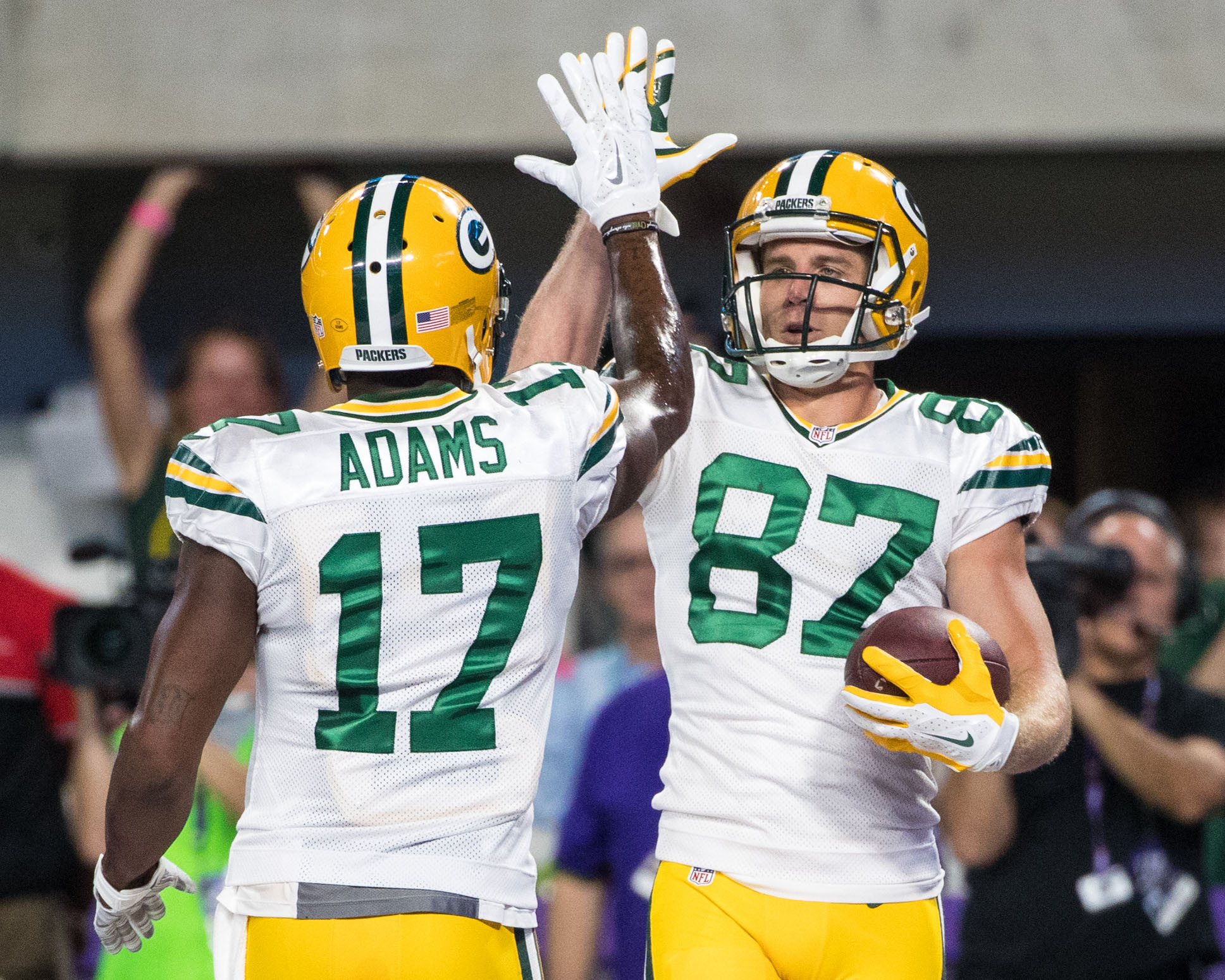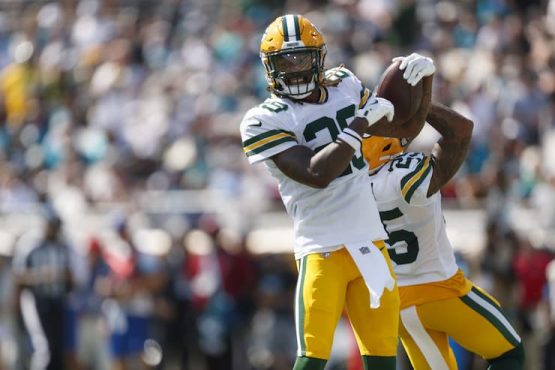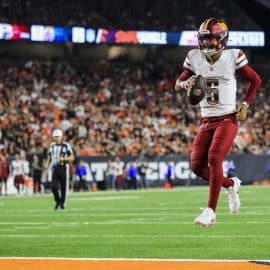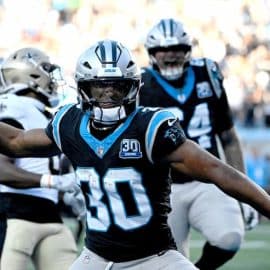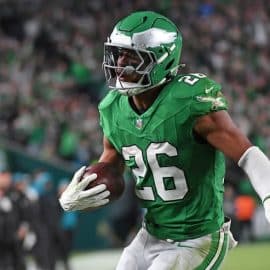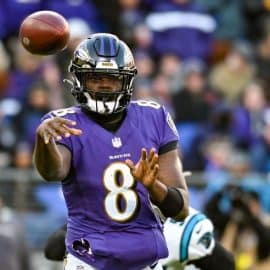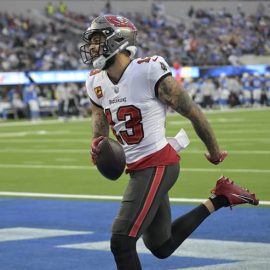The Green Bay Packers have had many great players suit up for the team in its 100-year history, but no position has more depth than wide receiver. With Jordy Nelson’s official retirement this week, here is a look back at the greatest Packers wide receivers of all time listed by decade.
Keep in mind that for this ranking, only the players’ performance as a member of the Packers is included. Players are not eligible to be listed in more than one decade even though some players may deserve consideration in more than one. I took the player’s best decade and then made him ineligible for all other years.
Each decade runs from the years 0-9 so the 1980s, for example, start in 1980 and end in 1989.
Only wide receivers are eligible for this list, tight ends and running backs are not included.
The years in parenthesis are the seasons each player was with the Packers.
Feel free to add your comments and picks after reading this article and enjoy this trip down memory lane.
1940s:
The 40s were the first full decade that accurate statistics for passing are recorded so we begin here.
Don Hutson (1935-45)
Hutson is the runaway choice for this decade. He led the NFL in receptions in eight of his 11 seasons with the Packers. No other player came close. In 1940, Hutson had 45 catches, the next highest Packers receiver had 16. The following year it was 58 catches for Hutson and just 22 for the next highest player on Green Bay. In 1942, Hutson grabbed 74 passes, no other player on the Pack had more than 21.
Hutson retired as the league’s all-time leading receiver and his 99 touchdown receptions remained a record until Steve Largent broke it more than 40 years later.
The “Alabama Antelope” invented the modern pass route and his speed and hands made him the greatest receiver of his era and arguably of all-time.
He was inducted into the Pro Football Hall of Fame in the hall’s inaugural class of 1963.
Clyde Goodnight (1945-49)
It was difficult to find another receiver to compliment Hutson on this list. Goodnight almost won by default. The University of Tulsa product was a third-round draft choice of the Packers in 1945 and led the team in receiving in 1946 and 1948. He finished his career with the Washington Redskins.
1950s:
The Packers struggled throughout the 50s until Vince Lombardi came in 1959 and turned the franchise around. The team still featured some very talented pass catchers.
Billy Howton (1952-58)
The Packers drafted Howton in the second round of the 1952 NFL Draft. Because of his great speed, he was immediately compared to Don Hutson and named as his heir apparent.
The Rice alum didn’t disappoint, leading the NFL in receiving yards twice (1952 and 1956) and in touchdowns once (1956). Howton earned All-Pro honors twice and was named to four Pro Bowl teams while with the Pack.
In 1956, Howton caught seven passes against the Los Angeles Rams for 257 yards and two touchdowns in a 42-17 Packers victory. The scores came from 63 and 36 yards out. That remains the franchise’s single-game yardage record by a receiver.
Vince Lombardi traded Howton to Cleveland before the 1959 season in the deal that brought Bill Quinlan and Lew Carpenter to Green Bay. He later played for the expansion Dallas Cowboys before retiring after the 1963 season.
Howton was inducted into the Packers Hall of Fame in 1974.
Bob Mann (1950-54)
Mann was a pioneer in addition to a very talented football player. He was the first African American player in Packers history after also holding that title with the Detroit Lions.
The Packers signed Mann late in the 1950 season after no other NFL team would sign the talented end. In his first full season with the Packers, he led the team with 50 catches for 696 yards and eight touchdowns. Mann finished second on the team in receptions the following two years.
Mann was inducted into the Packers Hall of Fame in 1988. After retiring from football, he went on to a successful career as a lawyer. Mann passed away at the age of 82 in 2006.
1960s
The Packers were a dynasty in the 60s, winning five championships in seven years from 1961-67 including the first two Super Bowls. The Pack became the first (and only team) in the playoff era to win three consecutive NFL titles from 1965-67.
Max McGee (1954, 57-67)
Max McGee is probably more famous for his outgoing personality, sense of humor and for his years as a Packers broadcaster, but he was also a very good end for the Packers in the 50s and 60s.
McGee was always able to reduce tension in the Packers locker room with his wise cracks and one-liners which was a big help when Coach Lombardi was yelling at the team.
He led the Packers in receptions four times and finished his career with 345 catches for 6,346 yards and 50 touchdowns.
https://www.youtube.com/watch?v=6ZRjJLMtzYM
McGee was the star of Super Bowl I, catching seven passes for 138 yards and two touchdowns including the first score in Super Bowl history. He shined in that game despite staying out until 6 AM the night before because he didn’t expect to play at all against the Chiefs.
After retiring, McGee served as the Packers radio color commentator from 1979-1998 and co-founded Chi-Chi’s chain of Mexican restaurants.
McGee was inducted into the Packers Hall of Fame in 1975. He died tragically in 2007 when he fell while cleaning leaves off his roof.
Boyd Dowler (1959-69)
Dowler joined the Packers in Vince Lombardi’s first season as coach and remained with the team for 11 seasons. He started his career with a bang by being named the NFL’s Rookie of the Year. He earned Pro Bowl honors twice (1965 and 1967) and was named to the NFL’s All Decade Team of the 1960s.
The University of Colorado product was 6’5” and was able to use his size to his advantage. Dowler caught 448 passes with the Packers and 40 touchdown passes. He was a member of all five of Vince Lombardi’s championship teams. Dowler caught two touchdown passes in the Ice Bowl and a 62-yard pass from Bart Starr in Super Bowl II.
He was inducted into the Packers Hall of Fame in 1978. He later served as an assistant coach and scout for several NFL teams after his playing days were over.
1970s
The 70s were a tough decade for the Packers franchise and arguably the weakest decade for the passing offense. It was a challenge to find receivers to fill these two spots.
Carroll Dale (1965-72)
Dale’s best years came in the late 60s, but he led the team in catches in 1970 and 1971 and was the leading wide receiver in 1972, the only year the Packers qualified for the playoffs in the decade.
The Virginia Tech product was traded from the Rams to the Packers before the 1965 season. Dale played eight seasons with Green Bay and led the team in catches for three straight years from 1969-1971. He also caught touchdown passes in both the 1965 and 1966 NFL Championship Games.
Dale had great speed and could get downfield for the big play. He averaged an impressive 19.7-yards per catch during his Packers career and scored 35 touchdowns on 275 receptions.
Dale finished his career with the Minnesota Vikings in 1973. He was inducted into the Packers Hall of Fame in 1979.
Ken Payne (1974-77)
The list of receivers from the 70s is sparse but Payne made the cut mostly because of his best season in the league in 1975. That year, the Oklahoma City native caught 58 passes for 766 yards on a team that won only four games. No receiver for the Packers caught more passes in a season during the entire decade.
Payne led the team in receptions again in 1976 with 33 catches but had a falling out with head coach Bart Starr the following season and was released by the team after only four games.
Payne finished his Packers career with 103 catches for 1,395 yards and briefly was the best receiver on a team that struggled to throw the football.
1980s
In the early 80s, the Packers became an aggressive passing team under Bart Starr and offensive coordinator Bob Schnelker. The result was a lot of yards if not a lot of wins. Still, the Packers had some of the most talented wide receivers in the league during this time.
James Lofton (1978-86)
The Packers selected Lofton in the first round of the 1978 NFL Draft and the speedster from Stanford quickly proved his value to the team.
Lofton was big, fast and strong and was a home-run threat every time he touched the football. He led the Packers in receptions eight times and was named to seven Pro Bowls while with Green Bay. Lofton retired as the Packers all-time leader in receiving yards with 9,656 and averaged an impressive 18.2-yards per catch with the Pack.
After leaving the Packers in 1987, Lofton played on the Bills during their run of four straight Super Bowl appearances in the early 1990s. He became the first receiver in NFL history to go over 14,000 yards receiving in his career.
Lofton was named to the NFL’s All-80s Team of the Decade and inducted into the Pro Football Hall of Fame in 2003. After retirement, he has enjoyed a successful career as a broadcaster.
John Jefferson (1981-84)
The Packers paid dearly for wide receiver John Jefferson when they acquired the holdout from the San Diego Chargers early in the 1981 season. The Pack surrendered a first-round pick, two second round picks, swapped positions in the first round in another draft and wide receiver Aundra Thompson to get Jefferson.
When JJ teamed with James Lofton, the Pack had the most dangerous receiving duo in the NFL in the early 80s. Quarterback Lynn Dickey could throw to Lofton, Jefferson or tight end Paul Coffman, all of whom made the Pro Bowl in 1982. That season, the Packers made the playoffs for the only time in the decade in part due to Jefferson’s presence.
JJ had a big game in the Packers playoff win against the St. Louis Cardinals, catching six passes for 148 yards and two touchdowns in Green Bay’s first postseason victory since the Ice Bowl.
Jefferson added confidence and swagger to a Packers team that needed it badly. His most productive season in Green Bay was 1983 when he caught 57 passes for 830 yards and seven touchdowns.
Unfortunately for Jefferson, Lofton remained the top receiving threat and got most of the passes thrown his way. Jefferson eventually grew frustrated by his lack of numbers and finished his career in 1985 with the Cleveland Browns.
1990s
By the 90s, the NFL became more of a situation substitution league so three-WR sets were common. As a result, we will feature three players from each decade from here forward when there were three worthy choices.
Again, the Packers featured some of the game’s best wideouts during this time as quarterback Brett Favre finally gave the Pack their first franchise quarterback since Bart Starr.
Sterling Sharpe (1988-94)
Sterling Sharpe became a force for the Packers once he arrived in 1988. The South Carolina product used his size and strength to catch contested balls and was by far the most reliable receiver the Packers had during his time in Titletown.
Sharpe led the NFL in receptions three times and twice led the league in touchdown catches. Early in his career, Favre knew if he was in trouble, he should always look in the direction of number 84.
Sharpe set a new NFL record with 108 catches in 1992, then broke his own mark the following year with 112 receptions. He also caught three touchdown passes including the last-minute game-winner in the Packers playoff win over the Lions in 1993.
Sharpe’s career was caught short by a neck injury late in the 1994 season. He was inducted into the Packers Hall of Fame in 2002 and would have been a strong candidate for the Pro Football Hall of Fame had his career not ended prematurely.
Antonio Freeman (1995-2001, 03)
Antonio Freeman and Brett Favre became one of the greatest duos in Packers history in the 1990s. Freeman had three straight 1,000-yard seasons from 1997-1999 and was named first team All-Pro in 1998. That season, Freeman had career-highs in receptions (84), yards (1,424) and touchdowns (14).
Freeman scored a key touchdown in the Packers Super Bowl XXXI win over the Patriots and then scored two more touchdowns in Super Bowl XXXII against Denver.
His most famous reception may be the off-the-back catch he made in the rain against the Vikings that gave the Packers an overtime win on Monday night at Lambeau Field.
https://www.youtube.com/watch?v=Lme6dBIGcfU
Freeman played eight seasons with the Packers and finished with 431 catches for 6,651 yards and 57 touchdowns. He was inducted into the Packers Hall of Fame in 2009.
Robert Brooks (1992-98)
Robert Brooks is another standout wide receiver for the Packers whose career was cut short by injury. His best season came in 1995 when the South Carolina alum caught 102 passes for 1,497 yards and 13 touchdowns.
He tied an NFL record (that can never be broken unless there is a major change in the rules) by catching a 99-yard touchdown pass from Brett Favre on Monday Night Football against the Bears.
Brooks was injured during the Pack’s 1996 Super Bowl season but came back to gain more than 1,000 yards the following season on 60 catches. He was named the NFL’s Comeback Player of the Year for his efforts.
During his career, Brooks released a rap song about the Lambeau Leap called “Jump in the Stands.”
Brooks later had back issues that eventually forced him to retire. He finished with 306 catches for 4,225 yards with the Packers and 32 touchdowns. He was inducted into the Packers Hall of Fame in 2007.
2000s
The Packers continued to get great quarterback play during this decade, first from Brett Favre and then late in the decade from Aaron Rodgers. The result was a strong pass offense that featured many fine receivers.
Donald Driver (1999-2012)
Donald Driver started his NFL career as an obscure 7th-round draft choice and ended it as the Packers all-time leading receiver.
In 13 seasons with the Pack, the Alcorn State alum caught 743 passes for 10,137 yards and 61 touchdowns. No player in Packers history has more receptions or yards. He also caught 49 more passes in the postseason for 675 yards and three touchdowns.
Driver was named to three Pro Bowls and was a member of the Packers 2010 Super Bowl championship team. He led the team in receptions six times.
His best season came in 2006 when Driver made 92 catches for 1,295 yards and eight touchdowns. Overall, he finished with seven 1,000-yard seasons and was the most reliable and consistent receiver on the team during his tenure with the Pack.
Driver was also very involved in the community and gave his time to numerous charitable organizations.
He was inducted into the Packers Hall of Fame in 2017.
Greg Jennings (2006-12)
Greg Jennings was a standout receiver for the Pack in the late 2000s and early 2010s. He had three consecutive 1,000-yard seasons from 2008-10 sandwiched around a pair of 900-plus yard campaigns.
Jennings made the Pro Bowl in 2010 and 2011 and was a key part of the Packers Super Bowl XLV championship team.
The former Western Michigan star twice led the Pack in receptions and scored two touchdowns in Green Bay’s Super Bowl win over Pittsburgh. He caught 425 passes in seven seasons with Green Bay for 6,537 yards and 53 touchdowns and added another 50 playoff receptions for 673 yards and six touchdowns while with Green Bay.
Jennings later played for the Vikings and Dolphins before retiring after the 2015 season. He presently works as a broadcaster calling NFL games for Fox Sports.
2010s
Aaron Rodgers became the best quarterback in the league early in this decade and led the Pack to another Super Bowl win in 2010. Rodgers had some very talented receivers to throw to throughout this decade which concludes at the end of this season.
Jordy Nelson (2008-14, 16-17)
Nelson had unbelievable chemistry with Aaron Rodgers. The two had an unspoken bond that allowed them to communicate with a quick glance and it made them very difficult to stop. Nelson’s back-shoulder passes from Rodgers were an easy way to pick up yardage when the Pack needed a quick strike.
The Kansas State product spent nine years with the Packers and led the team in receiving four times. His best season came in 2014 when Nelson made 98 catches for 1,519 yards and 13 touchdowns.
A preseason injury caused him to miss the 2015 season, but Nelson returned to lead the league with 14 touchdown catches in 2016 and was named NFL Comeback Player of the Year.
Nelson had an outstanding game in Super Bowl XLV, catching nine passes for 140 yards and a touchdown to lead all receivers.
The Packers let Nelson go after the 2017 season. He played with the Raiders in 2018 before announcing his retirement.
Nelson had 550 catches with the Packers for 7,848 yards and 69 touchdowns.
Davante Adams (2014-present)
Davante Adams has shown improvement in each of his five NFL seasons and is now one of the best receivers in the NFL.
The former Fresno State star had his best season in 2018, catching 111 passes for 1,386 yards and 13 touchdowns despite missing the season finale due to injury. He was selected to his second straight Pro Bowl due to his stellar performance.
Adams now has three straight seasons of 10-or-more touchdowns and has led the Packers in receiving in each of the last two campaigns.
https://www.youtube.com/watch?v=16P6kMXeWkE&t=48s
Aaron Rodgers always looks to Adams when he needs a big play and he trusts Adams more than any receiver on the roster.
In five seasons so far with the Packers, Adams has 348 catches for 4,197 yards and 39 touchdowns. He has added another 28 catches in the playoffs for 389 yards and four scores.
At 26, Adams is just entering his prime and his best football should be ahead of him.
Randall Cobb (2011-18)
Randall Cobb made his mark with the Packers in his first NFL game, returning a kickoff 108 yards for a touchdown and catching another touchdown pass in the Packers thrilling season-opening win against the Saints.
Cobb was a threat as a receiver, return specialist and could run the ball out of the backfield as well.
The Kentucky star enjoyed his best season in 2014 when he made 91 receptions for 1,287 yards and 12 touchdowns. He was selected to the Pro Bowl for his efforts.
Cobb remained a big part of the Packers offense through the 2018 season. In eight campaigns with the Pack, he totaled 470 catches for 5,524 yards and 41 touchdowns while catching another 47 catches for 596 yards and five scores during playoff games.
Cobb signed as a free agent with the Dallas Cowboys prior to the 2019 season and will continue his career in Dallas.
Follow Gil Martin on Twitter @GilPackers
Add The Sports Daily to your Google News Feed!
